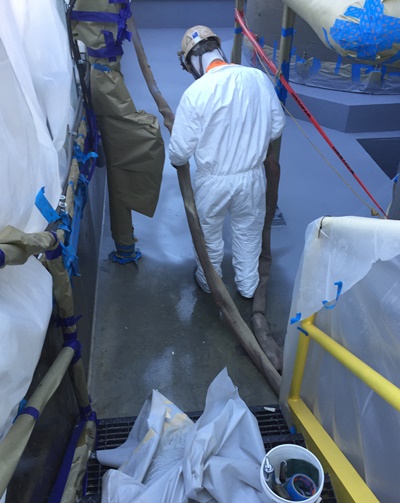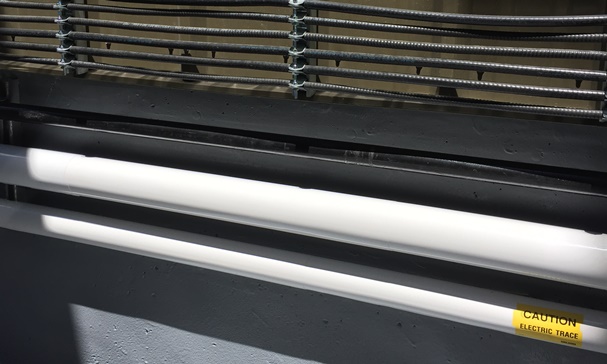In the mining industry, gold cyanidation is the most commonly used process to extract gold from ore. But due to the toxic nature of cyanide, proper containment is a must.
When a brand-new gold mill opened up last fall in the Western United States, sealing up the cyanide containment area, which included piping used in processing and the adjacent tanks, was essential. Fortunately for the mill, which wishes to remain unnamed, it struck gold by hiring Salt Lake City, Utah-based Vulcan Precision Linings as contractor.
“It was all new construction, so everything had to be up to code,” said Duane Broadhead, owner of Vulcan Precision Linings. “Once they poured the concrete, we had to seal it with a polyurea coating so that in case of an acid spill or leak, it doesn’t go into the environment.”
“The polyurea basically eliminates the porosity of the concrete,” Broadhead explained. “There are other methods, but they’re much more expensive and time consuming.”
In its project bid, Vulcan promised completion within five working days. So when the company’s four-man crew arrived at the mill and the 3,200-square-foot (297.3 m2) secondary containment area in early September, they went for gold.
Safety First!
Safety precautions, surface preparations, and masking took up close to half of the week-long project, Broadhead recalled. The crew began day one by watching a lengthy safety orientation video before preparing the surface over the remainder of day one and all of day two.
Wearing standard personal protective equipment (PPE) including full-face air masks, gloves, Tyvek coverall suits, and air-supplied blasting hoods from Clemco Industries, the crew began abrasive blasting the new concrete substrate with a 20/50 SHARPSHOT grit from material manufacturer Minerals Research, Inc. This was used to remove any old coatings and any contaminants.
Next, the crew washed the area with CHLOR*RID, a specialized salt and chloride removal product. CHLOR*RID is added to water and applied to the surface, where the chemicals in the solution bond with chloride and sulfate ions to remove them from the surface. The floors, sides, and tank pedestals of the secondary containment area were all abrasive blasted and cleaned through this process.
Once complete, the crew then tested the area for any residual salt.
“The idea is to get [the salt] to such a low amount that it doesn’t affect the adhesion,” Broadhead said.
In this case, fortunately, the combination of the SHARPSHOT grit and CHLOR*RID did its job, and tests showed the room was ready to have the coating applied.
But before the crew could begin priming and applying the polyurea, one more preparation step remained. With the job taking place outdoors in somewhat windy conditions, overspray was a concern. To mitigate the impact, the crew used the early part of day three to mask all items in the containment area that the company did not want sprayed with polyurea.
“It was quite the ordeal,” Broadhead said. “It cost us a lot of grief and a lot of time. There was a lot of piping in the area going to the cyanide tanks that hadn’t been activated. We usually see that in application at an existing facility where you’re going in to revamp, not at a new construction site. But there’s always something you don’t see coming.”
After taking a few hours to mask the piping with plastic and foam tape, it was finally time to begin coating!
Priming and Applying
The FSS50DM aromatic from VersaFlex, Inc. was chosen as the spray-applied polyurea. Before applying the polyurea,  though, the substrate had to be primed with the corresponding VF20 modified urethane primer from VersaFlex. The VF20, a two-component isocyanate and resin blend primer that boosts adhesion for coating systems, uses its low viscosity to allow for maximum concrete penetration.
though, the substrate had to be primed with the corresponding VF20 modified urethane primer from VersaFlex. The VF20, a two-component isocyanate and resin blend primer that boosts adhesion for coating systems, uses its low viscosity to allow for maximum concrete penetration.
The Vulcan crew rolled out the primer, using 9-inch (22.9 cm) and 3-inch (7.62-cm) rollers on the majority of the floors, sides, and tank pedestals. Brushes were used for the corners and any hard-to-reach nooks and crannies.
Depending on the temperature and humidity, the primer can take anywhere from 2 to 12 hours to cure, Broadhead explained. But with the September job taking place in ideal 75° F (23.9° C) temperatures with dry conditions, this job came in closer to the low end.
“If there’s high humidity and it’s cold, it can take 12 hours,” Broadhead said. “We’ve had 10- to 12-hour drying periods before. You have to get your crystal ball out and guess. Sometimes, with bad weather, we might have to be out there for two weeks [for the entire job]. But this one went as good as it could go.”
As a result, after using the remaining hours of days three and four to prime the area, the crew was able to return on the fifth and final day to apply the polyurea, right on schedule. Using a plural-component spray gun from Graco, the crew applied the FSS50DM aromatic at 100 to 120 mils (2,540.0‒3,048.0 microns) dry film thickness (DFT), with just eight seconds of gel time for each sprayed segment.
“It cures when it hits, basically,” Broadhead said. “There’s not really a wet side.”
There were a few minor spraying delays due to high winds, noted Broadhead, who said the crew was being mindful of potential overspray hazards. But even with those brief delays, the instant curing time of the polyurea enabled the crew to still finish the job on schedule.
Gold-Star Performance
After completing the spraying, the Vulcan crew unmasked the piping and tank areas and presented the completed secondary containment room to its client.
“We gave it a good visual inspection, made sure to clean the area, and got the customer to sign off on it,” Broadhead said. “The customer was very, very happy. But we don’t allow them not to be. We make it to where they’re satisfied completely.”
If the job took place even a month later, weather might have intervened. But proper planning and communication between the client and contractor found early September as an ideal time for efficient job completion, and the Vulcan crew delivered on their promise.
“We were fine on this one,” Broadhead said. “We generally quit spraying outside in the West around October 15, because it’s too cold and it gets dangerous.”
“Many clients will try to convince you to do it, but we don’t do things that fail. They might not like that, but that’s too bad,” Broadhead continued. “We have a very good reputation, and we want to keep it.”
On this job, the Vulcan crew did exactly that.
Article updated on 2/20/17 to correct terminology.
